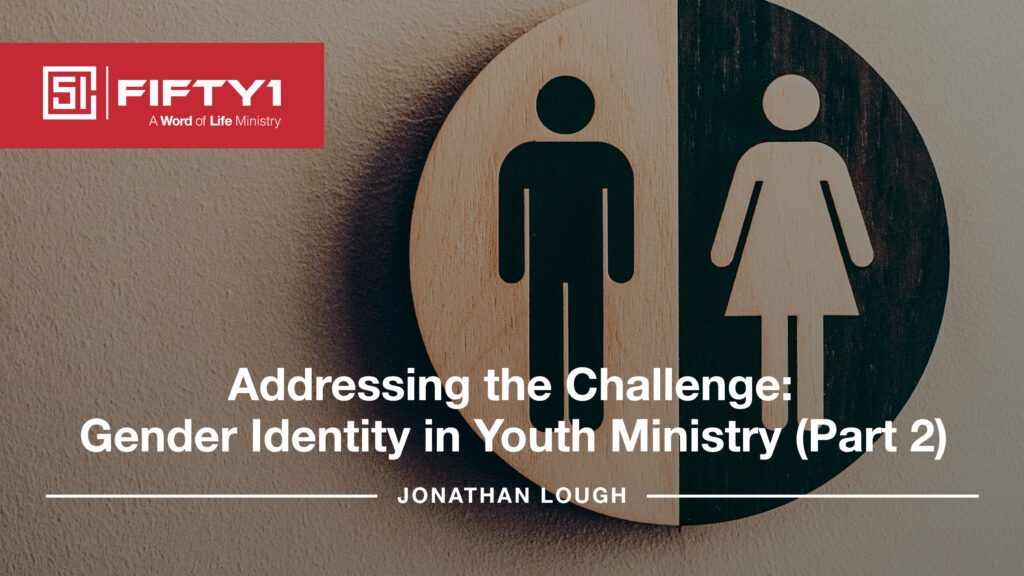When Jesus traveled throughout cities and villages and saw the crowds, His heart stirred with compassion (Matt. 9:35-38). Why? Because He saw they were harassed and confused, like sheep without a shepherd. Jesus did not view sinners as problems to be solved. Instead, He saw their need for a Savior.
As we deal with students who have false beliefs or who struggle with gender-related issues, Jesus’ vision and compassion must govern our words and actions.
Dealing with Students Who Believe Gender Is a Choice
Some students you encounter may believe gender is a choice, though they do not struggle with a gender-related issue. How do you deal with these students and prevent more from joining them?
First, teach sound doctrine early and often. In the previous blog, I referred to the false cultural ideologies of authenticity and authority as “doctrines.” The culture inundates young people with these misleading doctrines early and often. One would think that in the face of this, the church would push true doctrine early and often.
However, the Ligonier Ministries’ “State of Theology” report (2022) reveals that many churches do not instill true doctrine early and often. I frequently meet students who, despite growing up in church, lack a basic understanding of theology. As a youth leader, you may not be able to control the doctrines your students hear from their teachers and parents, but you can control what they hear from you. Teach them “what accords with sound doctrine” early and often so they might believe and live rightly (Titus 2:1).
Second, don’t shy away from biblically addressing tough topics. For many, topics like gender identity, same-sex temptation, or other cultural issues are intimidating. But these issues must be addressed wisely and biblically. If the church does not address them, the culture will and probably already has.
Third, guide them, don’t just inform them. The goal should be to lead students to the correct answer, not just tell them the correct answer. This happens by asking good questions and instructing them to study significant passages like Genesis 1–3 and Psalm 139.
Dealing With Students Who Struggle with a Gender-Related Issue
You may meet some students who struggle with gender-related issues such as gender dysphoria or transsexualism. How do we deal with these students?
First, listen with compassion. As with any student, we should jump at the opportunity to get to know the person struggling with a gender-related issue. Many young people who wrestle with gender identity issues feel as though they don’t belong anywhere. They need to know that the church is the best place for them. Ask them questions about their family, hobbies, and interests. And if they bring up their gender struggle and say, “You probably won’t understand,” respond with, “Can you help me understand?”
Second, hold fast to the truth. The teen struggling with gender-related issues needs to know the truth, even if it’s uncomfortable. It is possible to simultaneously listen and speak with compassion while standing on the truth of God’s Word. That is precisely what God’s Word calls us to do: speak the truth lovingly (Eph. 4:15). How you speak the truth in love may change from student to student.
Third, struggle together. Your students need to know that when they walk into the church, they are stepping foot in a place full of justified sinners (Rom. 3:22-24). A sinner should never walk into church and feel alone in their sin. Instead, they should be overwhelmed by a community of grace-filled and justified sinners who can walk alongside them as they wrestle against their flesh.
Fourth — and primarily — point them to the gospel and Christ’s power. If we believe the gospel is the power of God for salvation to everyone who believes (Romans 1:16), then our primary goal should be to point people to it. As we take students to the gospel, we should also point them to Christ’s power. In the gospels, Jesus radically changed people like the woman at the well (John 4) and Zacchaeus (Luke 19:1-10). The student struggling with their gender identity needs to know that Jesus, by His Spirit, will radically change them too (2 Cor. 3:18). It may take time, and it may not include taking away all temptation, but transformation will happen.
I acknowledge that a short blog fails to provide exhaustive information on such a complex issue. But hopefully, it provides a starting point. Ultimately, we should diligently obey 1 Thessalonians 5:17, “Pray without ceasing.” Only God changes hearts, so depend on Him.
For more information on this topic, read Andrew T. Walker’s “God and the Transgender Debate,” and Carl Trueman’s “Strange New World.”
Jonathan Lough is the assistant professor of theology at Word of Life Bible Institute in Pottersville, NY. He teaches Systematic Theology and Apologetics along with other classes as needed. Jon attended the Bible Institute for two years, served on a Word of Life traveling music team for one year, earned his bachelor’s degree at Cedarville University, and then graduated with his Master of Theology from Dallas Theological Seminary in 2022. Jon serves alongside his amazing wife, Lauren, whom he married in 2020.



1 thought on “Addressing the Challenge: Gender Identity in Youth Ministry (Part 2) ”
Jon, thanks for taking your time to share. I appreciate your wisdom on this.